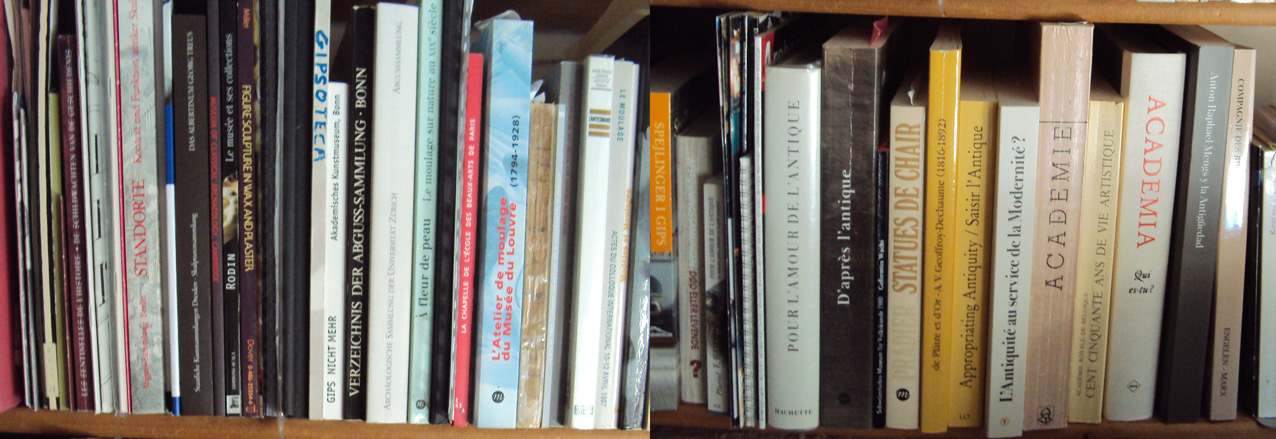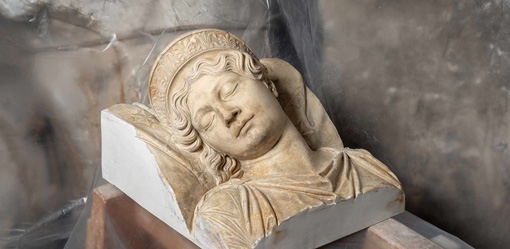Publications


l Museo dei Gessi dell'Università di Urbino, nella prestigiosa sede di Palazzo Albani, custodisce un piccolo, ma interessante, nucleo di calchi storici dalla statuaria antica e pseudo-antica. Si tratta di un lotto già appartenuto alla gipsoteca dell'Istituto di Belle Arti delle Marche (fondato a Urbino nel 1861) e tuttora in proprietà del Liceo Artistico "Scuola del Libro", erede dell'istituzione ottocentesca. Il volume ripercorre per via documentaria il lungo vissuto di questi gessi, ricostruendolo nel contesto storico-culturale che, attraverso tre secoli, ha interessato la collezione originaria e registrato fasi di alterne (s)fortune, trasferimenti e danneggiamenti, dispersioni (molte) e nuove acquisizioni (poche), oblii e rinnovati interessi. Offre inoltre il catalogo dei pezzi nel Museo. Rappresentativi della serie canonica di modelli della classicità che, dal Cinquecento in poi, sono stati assunti a riferimento per la formazione artistica, i gessi storici meritano oggi una specifica attenzione. La loro immagine, cristallizzata in forme che spesso non trovano più corrispondenza nelle sculture da cui derivano, testimonia storie di (de)restauri e (ri)elaborazioni dei nobilia opera, ma fornisce soprattutto una chiave di lettura sulla cultura figurativa contemporanea, nella quale questi modelli scultorei permangono con grande vitalità e in versioni anche molto pop.

Ellen Rehm , Wertvolle Kopien. Gipsabgüsse altorientalischer Denkmäler in Deutschland.
marru Studien zur Vorderasiatischen Archäologie Band 3 Supplement Münster: Zaphon 2020
Open acces: ISBN-978-3-96327-126-7-Rehm-Wertvolle-Kopien-Supplement.pdf
Addendum to the volume Maru 3 (Münster 2018)
in which more than 40 collections with over 400 plaster casts with their motifs have already been presented. Next to additions and new collections, this supplement takes an extended look at collections in the USA whose casts originate from Europe. Their collection policy differs from the European approach. The illustration section shows the new objects in addition to the distribution of the motifs in other media and old photos of collections
Contact : Prof. Dr. Ellen Rehm. Institut für Orientalistik. Universität Wienellen.
rehm@univie.ac.at.

Museum für Abgüsse Klassischer Bildwerke München

150-jähriges Bestehen.
Die Rückschau auf die Geschichte der Sammlung führt deren Höhen und Tiefen vor Augen und widmet sich gleichzeitig dem Sinn und Zweck von Abgüssen. Denn viele Besucher fragen sich: Warum sammelt man Gipsabgüsse?
Archäologen nutzen seit dem 19. Jahrhundert Abgüsse, um antike Plastik zu erforschen. Dabei vergleicht man die Statuen miteinander, stellt sie neu zusammen oder rekonstruiert verloren gegangene Formen und Farben. Gipse sind auch letzte Zeugen, wenn die Originalskulpturen verschollen sind. Andererseits standen Abgüsse schon immer im Fokus von Künstlern - bis heute.
Mit praxisnahen, handwerklichen, archäologischen und künstlerischen Schwerpunkten lässt Sie die Ausstellung in die Welt der Gipsabgüsse eintauchen, die vom Forschungslabor bis zum spielerischen Umgang mit der Antike reicht.


Nah am Leben - 200 Jahre Gipsformerei
Die Gipsformerei als älteste Einrichtung der Staatlichen Museen zu Berlin zeigt anlässlich ihres 200-jährigen Jubiläumsab 30.8. erstmals eine umfassende Präsentation ihrer Bestände: als Auftaktausstellung in der neueröffneten James-Simon-Galerie auf der Museumsinsel. Die Gipsformerei ist weltweit die größte noch existente Museumseinrichtung, die über ein Konvolut an historischen Gussformen sowie Modellen von mehreren tausend Stücken, die auf Werke fast aller Epochen und Weltkulturen zurückgehen, verfügt. Neben vielen Arbeiten unbekannter und bekannter Meister sind die Werke von berühmten Bildhauern wie Johann Gottfried Schadow, Schöpfer der Quadriga auf dem Brandenburger Tor, und Christian Daniel Rauch von besonderer Bedeutung.
Mit 200 Exponaten widmet sich die Schau der Lebend- und Naturabformung und macht deutlich, wie "nah" der Gipsabguss dem Leben kommen kann. Anhand einer "Gipsspur", die sich über die gesamte Museumsinsel hinzieht, wird die enge Verknüpfung der Gipsformerei mit den Skulpturenbeständen der Staatlichen Museen zu Berlin erfahrbar. Gezeigt werden alle Arten von Abgüssen, aber auch Gemälde, Bücher, Druckgrafiken, Fotos und Videos.

Volume 28, Issue 3, 2019
Editorial
Elisa Foster, Teresa Kittler, Eckart Marchand, Emma Payne , pp. 291
Introduction
Eckart Marchand , pp. 295-298
Research Article
'Plaister of Paris is [...] a production of Derbyshire': practical geology and the plaster revolution in British sculptors' workshops, 1745-1845 M. G. Sulliva , pp. 299-314
Canova, 1816: marble, plaster, surface Sarah Betzer , pp. 315-330)
The Smugglerius, re-viewed Meredith Gamer, pp. 331-344
Sanchi, in and out of the museum Kavita Sing, pp. 345-364
Circulating casts of the Coatlicue: Mariana Castillo Deball's unearthing of the Aztec earth goddess's history of reproduction and display Jennifer Reynolds-Kaye, pp. 365-380
Copies and connoisseurship: Luca della Robbia's Visitation in America, 1888-1909 Catherine Kupiec, pp. 381-396
Sources & Documents
Aby Warburg on plaster casts Eckart Marchand, pp. 397-408
Statement before a committee of the Hamburg Parliament on 9 December 1909 Joseph Spooner, pp. 409-414
Reviews
Christina Neilson, pp. 415-418
Notes on Contributors pp. 419
For loading online : https://online.liverpooluniversitypress.co.uk/toc/sj/current

Suite à l'ouverture de la galerie des moulages d'art et d'archéologie de l'UCLouvain dans un espace du Musée L, cette publication (parution mars 2020) en retrace toute l'histoire depuis sa création en 1864.
Auteur : Bernard Van den Driessche.
A commander : https://pul.uclouvain.be/book/?gcoi=29303100775900

My Life as a Replica: St John's Cross, Iona
In 1970 a concrete replica of the St John's Cross arrived in Iona sitting incongruously on the deck of a puffer delivering the island's annual supply of coal. What is the story behind this intriguing replica? How does it relate to the world's first ringed 'Celtic cross', an artistic and technical masterpiece, which has been at the heart of the Iona experience since the eighth century? What does it tell us about the authenticity and value of replicas? In this fascinating book, Foster and Jones draw on extensive interdisciplinary research to reveal the composite biography of the St John's Cross, its concrete replica, and its many other scale copies. They show that replicas can acquire rich forms of authenticity and value, informed by social relations, craft practices, creativity, place and materiality.
Thus, the book challenges traditional precepts that seek authenticity in qualities intrinsic to original historic objects. Replicas are shown to be important objects in their own right, with their own creative, human histories - biographies that people can connect with. The story of the St John's Cross celebrates how replicas can 'work' for us if we let them, particularly if clues are available about their makers' passion, creativity and craft.
ISBN: 9781911188599 | Published by: Windgather Press | Year of Publication: 2020 | Language: English 224p, H246 x W189 (mm) b/w and colour
There's a free preview here https://textcafe.co/books/7v20EX/?1590182551055#/